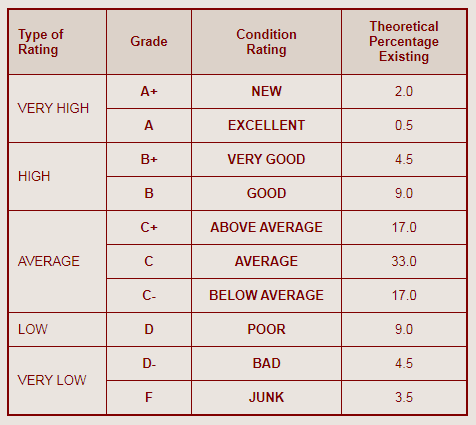-------------------
The condition of ham equipment has a profound effect on its assessed value.
This Grading Scale is offered as a aid for eliminating confusion and misconceptions inherent when establishing an overall "grade" to represent the judged condition of amateur radio equipment.
This scale is guideline and not a set of rigid rules (See Examples of interpretations, below).
Grading Chart
For detailed explanation of each Grade, see charts, below.

Examples of interpretations:
- An item bought from a dealer but remaining in its factory sealed box would be an A.
- The same item, no longer in its factory sealed box, little used and is still in the same condition as when NEW would rate a grade of A-.
- The same item, used, looking and performing like new but having been modified is given a B+ rating because it it no longer AS NEW.










Notes on using this Grading Scale
- When grading a piece of equipment, the following should be kept in mind.
- The main objective of of this rating approach is to improve equipment-grading reliability and provide consistency of results.
- The definitions used do not attempt to change the common meaning of the terms. Instead, the standards provide criteria for making judgments and deciding which grade category matches the target equipment.
- Equipments' rating is be based solely upon what can be seen and learned of the equipment through a visual and hands-on inspection, including powering-up the equipment (if applicable), and determining whether all originally specified functions and features, as given in the manufacturer’s specifications, are working properly and satisfactorily.
- These ratings are only concerned with equipment condition. Ratings are not based upon the perceived value or age of the equipment. A totally useless piece of equipment might have a graded EXCELLENT (A), and a highly sophisticated, current production item might have a BAD (D-) grading. Also, the chronological age of equipment does not affect its grading. Even if a piece of equipment is totally obsolete, it could have an VERY GOOD (B+) rating.
- Equipment is rated using the manufacturer’s specifications. The rater uses his experience and common sense to make any judgments relative to manufacturer’s published specifications.
- Modified equipment is eligible for all grade categories except NEW (A+) and EXCELLENT (A). Generally speaking, professionally done equipment modifications, enhancing the equipment's usefulness and/or performance, will not reduce the rating. Modifications that collectively and/or individually detract from the usefulness and/or performance of the equipment can lower the rating.
- The addition of a manufacturer’s (or third party manufactured) accessory to equipment is not considered a modification, since the manufacturer intended that certain accessories be used with the equipment. For example, the addition of a filter to a receiver, using a filter designed for the receiver, should not considered a modification of the receiver.
- The a fully serviceable user’s manual or other suitable user-documentation, often including user’s instructions, schematics, and other technical information, usually has a unique part number, and is part the equipment. If it is missing, the equipment is incomplete and the rating of the equipment will be lowered, in some cases. NEW (A+) and EXCELLENT (A) equipment should always have a proper ORIGINAL manual; equipment that is VERY GOOD (B+) or GOOD (B) should have a complete, readable manual. This requirement does not apply if the manufacturer did not originally provide a manual or other suitable user-documentation with the newly delivered equipment.
- Interconnecting cables, originally furnished by the manufacturer, also are part of the equipment. If manufacturer-supplied interconnecting cables are missing, the equipment is incomplete and the rating of the equipment might be lowered in some cases.. This means that, to be rated as VERY GOOD (B) or higher, a complete set of interconnecting cables should accompany the equipment, if normally supplied by the manufacturer when originally sold.
- If equipment has been used and/or stored in a "smoking" environment, and has detectable tobacco or other smoke-particle residue inside and/or outside of the equipment, its rating should be lowered. NEW (A+), EXCELLENT (A) or VERY GOOD (B+) rated equipment must not have any detectable smoke residue. ANY detectable smoke residue limits equipment grade to no higher than GOOD (B).
The relationship of the type of rating and the anticipated percent of equipment deserving each rating is provided in the following table. This table is based on a normal hypothetical distribution of all radio equipment in the world.
For example, if it were possible to locate, inspect, and rating a particular model of all radio towers, ever made, by a certain manufacturer in the world and assign a condition rating to each and every tower, we would expect that about one-third (33%) of the towers would deserve a AVERAGE rating. Of course, this is hypothetical, since it would be impossible to find all such towers, much less inspect them. These theoretical percentages are provided with each rating description.
For traders attempting to find a particular piece of equipment in a certain condition, the Theoretical Percentage Existing estimates might be helpful. For example, the chances of finding a NEW Kenwood TR-7950, 2 meter transceiver is about 2 percent (2 out of 100). Not encouraging. The chances of finding one in AVERAGE condition is 33 percent (1 out of 3). Much easier.

